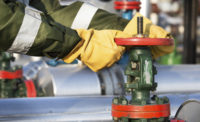 NIOSH researchers involved in an effort to characterize chemical hazards in the oil and gas extraction industry have found elevated levels of silica exposure during hydraulic fracturing operations.
NIOSH researchers involved in an effort to characterize chemical hazards in the oil and gas extraction industry have found elevated levels of silica exposure during hydraulic fracturing operations.
Researchers working on the “NIOSH Field Effort to Assess Chemical Exposures in Oil and Gas Workers” made the discovery while visiting numerous well sites in wide-ranging states over the past three years to characterize chemical exposures to workers during hydraulic fracturing operations.
“Since that time, we have shared our research findings with industry, and we have worked collaboratively with industry to develop engineering and administrative controls for silica,” said NIOSH Director Dr. John Howard.
In addition, NIOSH developed and successfully tested a control technology, the Mini-baghouse Retrofit Assembly, which reduces the amount of silica dust released from sand moving machines during hydraulic fracking operations. This technology is currently patent pending and NIOSH has received applications to license and commercialize it.
Howard said that based on the research findings, the industry moved rapidly to establish a “Respirable Crystalline Silica Focus Group” that has encouraged dialogue between NIOSH and the industry, helped companies understand silica exposures, and developed a guidance document on actions employees and employers can take to prevent exposures.
Other areas of research by the NIOSH Oil and Gas Extraction Sector Program include injuries and fatalities from falls and fires and explosions during drilling and well servicing operations and a continued focus on motor vehicle safety. The chemical exposure team is also expanding their work to look at exposures during other well servicing and drilling operations.
“A common thread through all of this research is collaboration with industry partners and with the members of the NORA Oil and Gas Extraction Sector Council, and a focus on producing practical outputs for workers including training materials and informational products,” said Howard.



